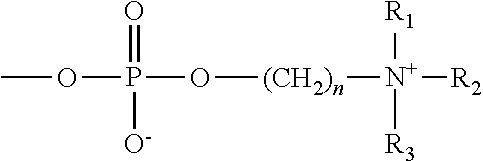Silicone hydrogel lens with a crosslinked hydrophilic coating
a technology of hydrophilic coating and silicone hydrogel, which is applied in the field of silicone hydrogel contact lenses, can solve the problems of haziness, inconvenient use, and incompatible wetting agents with silicone components, and achieve the effect of good coating durability
- Summary
- Abstract
- Description
- Claims
- Application Information
AI Technical Summary
Benefits of technology
Problems solved by technology
Method used
Image
Examples
example 1
Oxygen Permeability Measurements
[0087]The apparent oxygen permeability of a lens and oxygen transmissibility of a lens material is determined according to a technique similar to the one described in U.S. Pat. No. 5,760,100 and in an article by Winterton et al., (The Cornea: Transactions of the World Congress on the Cornea 111, H. D. Cavanagh Ed., Raven Press: New York 1988, pp 273-280), both of which are herein incorporated by reference in their entireties. Oxygen fluxes (J) are measured at 34° C. in a wet cell (i.e., gas streams are maintained at about 100% relative humidity) using a Dk1000 instrument (available from Applied Design and Development Co., Norcross, Ga.), or similar analytical instrument. An air stream, having a known percentage of oxygen (e.g., 21%), is passed across one side of the lens at a rate of about 10 to 20 cm3 / min., while a nitrogen stream is passed on the opposite side of the lens at a rate of about 10 to 20 cm3 / min. A sample is equilibrated in a test media ...
example 2
[0110]Preparation of Chain-Extended Polydimethylsiloxane Vinylic Macromer with Terminal Methacrylate Groups (CE-PDMS Macromer)
[0111]In the first step, α,ω-bis(2-hydroxyethoxypropyl)-polydimethylsiloxane (Mn=2000, Shin-Etsu, KF-6001a) is capped with isophorone diisocyanate (IPDI) by reacting 49.85 g of α,ω-bis(2-hydroxyethoxypropyl)-polydimethylsiloxane with 11.1 g IPDI in 150 g of dry methyl ethyl ketone (MEK) in the presence of 0.063 g of dibutyltindilaurate (DBTDL). The reaction is kept for 4.5 h at 40° C., forming IPDI-PDMS-IPDI. In the second step, a mixture of 164.8 g of a,w-bis(2-hydroxyethoxypropyl)-polydimethylsiloxane (Mn=3000, Shin-Etsu, KF-6002) and 50 g of dry MEK are added dropwise to the IPDI-PDMS-IPDI solution to which has been added an additional 0.063 g of DBTDL. The reactor is held for 4.5 h at about 40° C., forming HO-PDMS-IPDI-PDMS-IPDI-PDMS-OH. MEK is then removed under reduced pressure. In the third step, the terminal hydroxyl-groups are capped with methacryloy...
example 3
Preparation of Lens Formulations
[0113]A lens formulation is prepared by dissolving components in 1-propanol to have the following composition: 33% by weight of CE-PDMS macromer prepared in Example 2, 17% by weight of N-[tris(trimethylsiloxy)-silylpropyl]acrylamide (TRIS-Am), 24% by weight of N,N-dimethylacrylamide (DMA), 0.5% by weight of N-(carbonyl-methoxypolyethylene glycol-2000)-1,2-disteaoyl-sn-glycero-3-phosphoethanolamin, sodium salt) (L-PEG), 1.0% by weight Darocur 1173 (DC1173), 0.1% by weight of visitint (5% copper phthalocyanine blue pigment dispersion in tris(trimethylsiloxy)silylpropylmethacrylate, TRIS), and 24.5% by weight of 1-propanol.
Preparation of Lenses
[0114]Lenses are prepared by cast-molding from the lens formulation prepared above in a reusable mold, similar to the mold shown in FIGS. 1-6 in U.S. Pat. Nos. 7,384,590 and 7,387,759 (FIGS. 1-6). The mold comprises a female mold half made of quartz (or CaF2) and a male mold half made of glass (or PMMA). The UV irr...
PUM
| Property | Measurement | Unit |
|---|---|---|
| temperature | aaaaa | aaaaa |
| weight average molecular weight | aaaaa | aaaaa |
| weight average molecular weight | aaaaa | aaaaa |
Abstract
Description
Claims
Application Information
 Login to View More
Login to View More - R&D
- Intellectual Property
- Life Sciences
- Materials
- Tech Scout
- Unparalleled Data Quality
- Higher Quality Content
- 60% Fewer Hallucinations
Browse by: Latest US Patents, China's latest patents, Technical Efficacy Thesaurus, Application Domain, Technology Topic, Popular Technical Reports.
© 2025 PatSnap. All rights reserved.Legal|Privacy policy|Modern Slavery Act Transparency Statement|Sitemap|About US| Contact US: help@patsnap.com



